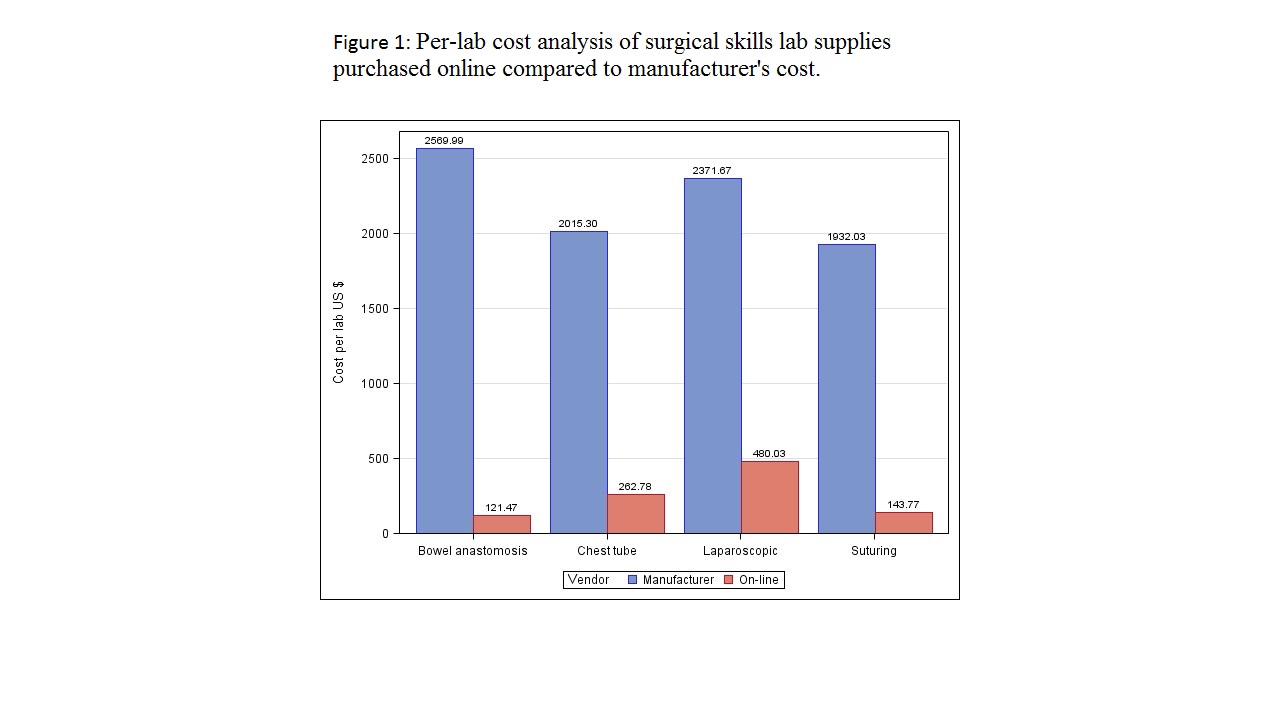E. Schneider2, P. J. Schenarts1, V. Shostrom3, C. H. Evans1 1University Of Nebraska Medical Center,Department Of Surgery / Division Of Acute Care Surgery,Omaha, NE, USA 2University Of Nebraska Medical Center,College Of Medicine,Omaha, NE, USA 3University Of Nebraska Medical Center,College Of Public Health/Department Of Biostatistics,Omaha, NE, USA
Introduction:
Surgical education is witnessing a surge in the use of simulation, as time in the OR is too valuable to be used for the acquisition of basic surgical skills. Simulation provides learners the opportunity to become familiar with instruments, improve dexterity, and gain knowledge about surgical techniques outside of the OR. However, implementation of simulation is often cost-prohibitive. Online shopping offers a low budget alternative. The aim of this study is to design and implement cost-effective surgical skills labs and analyze online versus manufacturers’ prices to evaluate for savings.
Methods:
Four surgical skills labs were designed: suturing, tube thoracostomy, bowel anastomosis and laparoscopy, for the general surgery clerkship from July 2014 to June 2015. Each lab was 2 hours in length, including a 30 minute lecture followed by 90 minutes of practice led by 3 faculty surgeons. Skills labs were implemented using hand-built equipment and instruments purchased online on Ebay, Amazon or eSuture. The online and manufacturers’ prices of supplies were compiled and compared. Learners were asked to rate their level of satisfaction (1=not satisfied to 5= highly satisfied) for all educational activities during the clerkship, including live lectures, small group activities and the skills labs.
Results:
119 third year medical students participated in each of the 4 skills labs. Supply lists and costs were compiled for each lab, with per-lab and per-year costs calculated by adding durable and disposable equipment costs. A descriptive cost analysis of online and manufacturers’ prices was performed. Per-lab costs are shown in Table 1. Online prices were substantially lower than manufacturers, with a per-lab savings of: $1779.26 (suturing), $1752.52 (chest tube), $2448.52 (anastomosis), and $1891.64 (laparoscopic), resulting in a per-year savings of $47,285. A general linear model and pairwise comparisons of satisfaction scores was completed, and p-values adjusted using Tukey’s adjustment for multiple comparisons. Satisfaction scores for the skills labs were 4.32, with statistical significance when compared to live lectures at 2.96 (p<0.0001) and small group activities at 3.67 (p<0.0001).
Conclusion:
A cost-effective approach for design and implementation of surgical skills labs showed substantial savings on a per-lab and per-year basis. By utilizing online resources to purchase surgical equipment for use in nonhuman settings, surgical educators overcome financial obstacles limiting the use of simulation and provide learning opportunities that medical students perceive as beneficial to their education.
